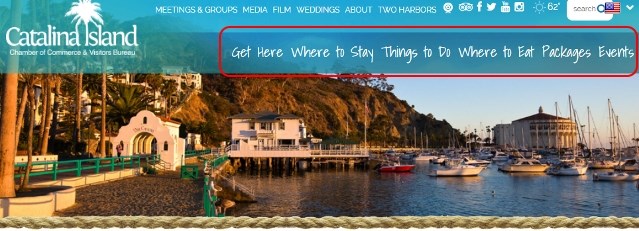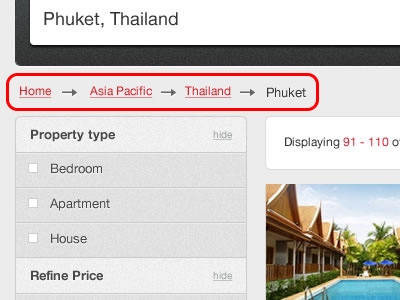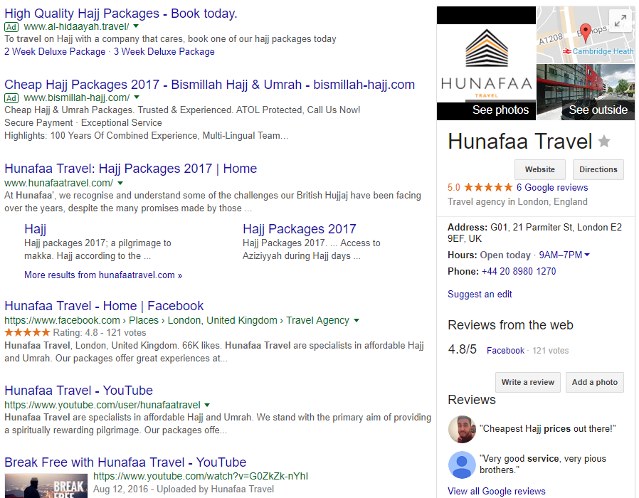
Summer! The best season for taking a break from duties and kicking back someplace nice – at the beach, for example. I hope I won’t be too old next month for building castles in the sand. On the other hand, some of my colleagues prefer snowy environments for their vacations. To each their own, but it all comes down to choosing the right place to spend your free time and the means of getting there.
The Internet helps a lot in making that choice, but most people limit their options to the sites that appear on the first page of search results. That leaves two options for travel agencies: pay-per-click advertising and arduous SEO. The latter, when done right, makes for a powerful long-term marketing strategy that secures a site’s place in the highest ranking positions for long periods of time, which makes it worth discussing. So let’s take a look at what constitutes effective SEO for travel websites.
- Make Your Site Mobile-Friendly
After a long period of praying, cursing and burning sacrifices at Mountain View, the mobile-first index is no longer a distant dream, but reality. This has been, of course, in response to the growing number of mobile Internet users, and you can be sure your travel website will be visited by plenty of them. People are more likely to book tickets on your site from a mobile device, and it’s even more likely for the device to accompany them in their travels than for a laptop. As part of making your site mobile-friendly, it’s crucial to have a responsive web design and fast page load times. Tools like WebCEO’s Website Audit can help ensure your site meets these essential criteria.
So stay informed about Google’s mobile ranking factors and be prepared.
- Use responsive web design: a website should look good and be easy to use on any device.
- Reduce page load time: users don’t like to wait. They want their business finished as quickly as possible, and the longer they have to wait until the page loads, the greater the chance they’ll just lose patience and leave. Be sure to publish your mobile website in the AMP format for superfast page loading times.
- Optimize your images: the less their file size, the faster a page loads. You’ll have to find the balance between your images’ size, dimensions and quality.
- Don’t use small text: it’s rather tedious to enlarge the picture on the screen every single time you need to read something, isn’t it? Best to avoid that and make the text large enough for people to read it without any extra effort.
- Avoid using small touch elements: if your page has a button you want to be pressed or a box you want to be checked, better not make them easy to miss or too small for their big thumbs.
- Flash animation: of course, users take priority over search engines, but Flash is still useless SEO-wise. Consider looking for an alternative if it can increase your SEO performance.
- No unnecessary intrusive interstitials: only popups that ask the visitor about using cookies or a single demographic query qualify as essential. A Google penalty algorithm for other kinds of interstitials that disrupt UX has been out since January.
- Pave a Path to Your Site with Keywords
Let’s say somebody wants to visit Paris. When does their trip begin? The moment they set foot in Paris? Wrong. Maybe when they board the plane? Also wrong. Then it has to be when they leave their home, grab a taxi and head to the airport, right? Still not even close.
The correct answer: it’s as soon as they make up their mind about visiting Paris. And your own work begins even earlier than that: your task is to predict how the traveler-to-be will try to accomplish their goal. They’ll most certainly turn to the Internet for help, and they’ll probably use your services, but there’s an important link between these two events that will decide whether or not that person will become your customer.
Keywords.
Words and phrases that pull site pages from the abyss of the Internet and right into the search results for users to see. They are the cornerstone of SEO and you want to pick only the best for your site. So how to find profitable keywords? The first steps are understanding your customers’ buyer journey and search intent, but of course it’s just the beginning. Finding these keywords can be streamlined with a tool like WebCEO’s Keyword Research.
Since you are a travel bureau whose job is to send people from one place to another (with class!), your keywords have to be appropriate for your line of work. That means be as specific as you can. If you can offer your clients a ‘plane from London to Paris’, that’s the keyword you should be using. If you can help them ‘book a hotel in Paris’, there’s another. Variations of the phrases are welcome. That’s long-tail keywords for you: long, specific phrases that describe precisely what your prospective customers want and convert for that very reason. When you are prepared to answer people’s needs, they will use your services instead of a different agency’s.
In order to pick the ideal travel-related keywords for your website, let them be service-specific and destination based. The travel industry doesn’t tolerate vagueness.
- Leverage Social Networks
Although word of mouth prevails as the main factor instigating people to travel around the world, social media is steadily catching up. It’s hardly surprising: the world is filled with wonders of nature and historical landmarks, and humans are impressionable creatures. A single well-made photo can cause them to pack their suitcases, and several days later they will share their own experiences on Facebook and Instagram. And the cycle continues.
There’s a nice synergy between social networks and visual media. The travel industry has plenty to show, which is a compelling reason for using social media in order to promote your services. As I said before, a journey begins with the decision to travel, and this decision is easily made stronger by pictures and videos showing the world. They can’t replace the real thing, but they are great for sparking interest.
Be sure, however, to post compelling photos that haven’t already been imprinted in everyone’s mind. Do a Google Image Search to be sure a given photo hasn’t been published 10,000 times.
- Start a Blog (around the world in 80 posts)
Blogging goes well with travel business, too. There’s no better way to gain more backlinks for your site than new content. Especially if it’s entrancing, exotic and exciting. Breath-taking landscapes, places rich with history, cultural events that you don’t see every day – world travel is an inexhaustible source of blogging material!
And you know how some people throw a dart at the map and go wherever it lands? Imagine having a “random post” button on your blog that works by that principle. If your blog was filled with countless amazing posts about interesting places, I’d totally read that myself. Tell your visitors lots of stories that will inspire them to travel with you – and then share stories of their own.
- Build Links from Authoritative Travel-Related Sources
Now that our traveler has decided to go on an adventure, their next step is picking a travel agency among the many. How will they make their choice? They’ll give preference to the sources they trust most. They’ll listen to their friends and acquaintances who have used services of this and that agency and can recommend it (or the opposite). If they don’t have any friends with this knowledge, the next option will be unbiased online sources. Needless to say, if there’s no mention of your business in those sources, those customers won’t be yours. This is where building a strong online presence becomes essential. Utilizing a tool like WebCEO’s Competitor Backlink Spy can help you understand and improve your online positioning.
So, link building is a huge aspect of travel SEO.
There are many popular travel websites where you can earn a valuable link to your site, such as:
Not only will they improve your website’s SEO and place it higher in Google’s ranking positions, they’ll also be a major help in building your agency’s online reputation.
- Place Navigation on Your Site
Every website with a large number of pages must have a well-designed internal link structure. It’s recommended that no two pages be further than three clicks away from each other for an optimal user experience. The best way to ensure this is to put up a site navigation.
Another way is to put breadcrumb trails in the top of your pages. They work great when content on your site is divided into sections which, in turn, are divided into subsections – and so forth. Isn’t it neat when you can keep track of how you’ve been browsing a resource without trying?
- Use Colorful Visual Content
Social media isn’t the only place where you should actively use visual content. Your own website is supposed to have it, as well. Pictures and videos leave a much more powerful impression on viewers than raw text. Let the imagery do the main work, and the words complement it.
Videos in particular have a strong potential to amaze your visitors and motivate them to embark on a journey. When their desire to travel is burning, there’s your site, ready to fan the flames. That’s when visitors become your customers.
- Fill Out a Schema Markup for Your Site
Schema markups are probably the coolest feature Google has ever implemented on its first page. They only really work for sites in the very first positions in search results, but you can pack them with lots of useful information for users to see before they even click on your link. Naturally, they are supposed to click after they are done admiring the schema, so it’s up to you to make it look as presentable and authoritative as possible.
An absolute must-have is a review schema. A large number of reviews and five stars (or at least a value above 4.5) convince your prospective clients about your agency’s competence better than any commercial. It’s like magic, or perhaps even better.
- Spy on Your Competitors
If there exists a niche without any competition, travel is definitely not it. Sorry I’m not sorry. You knew what you were getting into when you opened your agency, and I admire your courage. The powers that be tend to favor those with courage. There is a way to turn your rivals into your allies: you spy on their travel websites.
Analyzing their sites with your own two eyes is a good start, but will only get you so far. You can also use WebCEO’s tools to get a better evaluation of your competitors’ SEO strategies. Things worth investigating:
- How they rank for the keywords you’re using: if they are ranking too well, you might consider picking new ones they forgot to optimize their landing pages for. After checking how your competitors are doing for a basket of keywords you’ve chosen, go to the WebCEO Keyword Research tool to find great keywords you can dominate with.
- Domains that link to them, sorted by authority or popularity: the best backlinks your competitors have could also link to you, too. The WebCEO Competitor Backlink Spy can show you the various industry specific articles, forums and publications your competitors are mentioned in. You will soon know exactly what you’ll need to do to compete with them.
- Their activity in social networks: Are you in the lead on this battlefield of mentions, likes, shares and comments? Google notices most such activity. Do you need to step up your game?
Doing business without a competitor analysis strategy is like playing blackjack with a single card in your hand. Fortunately, spying on your competitors’ websites is easier than bugging their offices (and much more legal). All of their hidden aces will become plain for you to see online.





